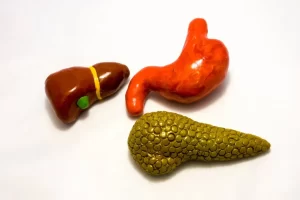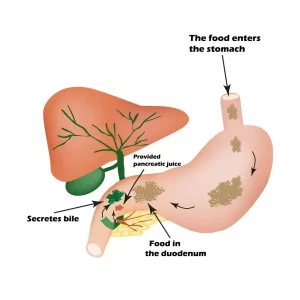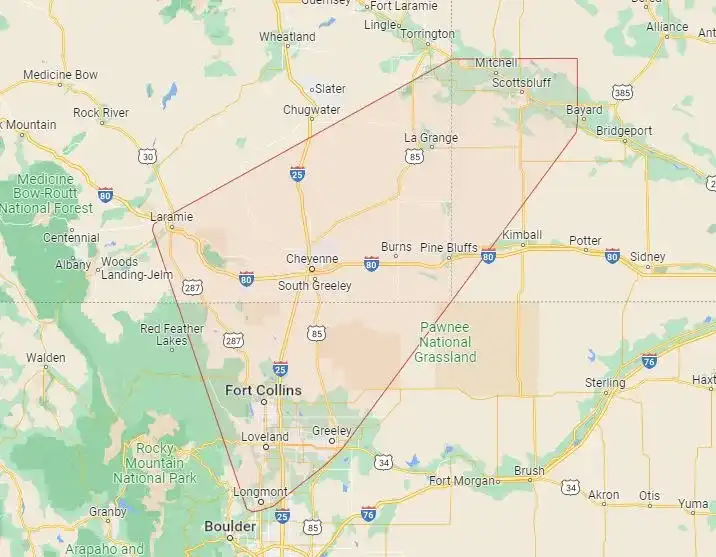The biliary system refers to the organs that are responsible for producing and storing bile and impacting the digestive and metabolic processes. Bile is a fluid that aids the process of nutrient absorption, digesting fat, and waste removal. The gallbladder stores and concentrates bile, which is a fluid produced in the liver to help digest the fat contained in food. The liver is the body’s largest internal organ. It plays a vital role in digestion, producing bile to breakdown food. It also plays a crucial role in eliminating waste by breaking down toxins before they are flushed out. The liver is also a production center for several enzymes crucial to metabolism. The pancreas balances the body’s blood sugar by producing insulin, which is the enzyme that controls blood sugar levels.
The gallbladder, liver, and pancreas are also organs that can develop fatal cancers if not diagnosed and treated early enough. When someone develops a tumor within the bile duct, gallbladder, liver, or pancreas, surgery is usually required. Surgery removes part or the entire diseased organ and surrounding tissue, if necessary. These procedures were once done using open abdominal surgery in the past, but are currently performed using minimally invasive robotic surgery. Long-term treatment is often necessary for patients in severe cases.
The recommended solution for the pancreas or liver that develops an infection resulting from diseases or cancer is Hepato-Pancreato biliary surgery (HPB).
Endoscopic retrograde cholangiopancreatography (ERCP)
This procedure is used to obtain a biopsy of the tumor and also to relieve biliary obstruction related to the tumor by placement of a stent.
Whipple Procedure
This procedure is also known as a pancreaticoduodenectomy. It involves removing the head of the pancreas, the duodenum, the distal bile duct and the gallbladder. This procedure is performed when the tumor is located in the head of the pancreas. The whipple surgical procedure is performed through both open and robotic approaches by Dr. Tierney.
Extrahepatic bile duct resection
This procedure removes the portion of the bile duct that is located between the liver and the head of the pancreas.
Liver resection
This procedure is necessary for intrahepatic cholangiocarcinoma (tumor located in the liver or Hilum).
The biliary system refers to the organs that are responsible for producing and storing bile. Bile is a fluid that aids the process of nutrient absorption, digesting fat, and waste removal. When someone develops a tumor within the bile duct, gallbladder, liver, or pancreas, surgery is usually required. Complex biliary surgery consists of an operation on the gallbladder, bile ducts, and other structures involved in producing and transporting bile between the liver and the gastrointestinal tract. The biliary tree consisting of the liver, gallbladder, and bile ducts is essential to the body’s digestive and metabolic functions. These enzymes are involved in converting food into energy. These organs can be affected by several disorders including gallstones and liver cancer.
Historically, this surgery has used open abdominal methods. However, more modern techniques include laparoscopy and minimally invasive robotic surgery which has a shorter hospital stay.

When technically practical, minimally invasive duct repair (robotic) is preferred because of the reduced rate of complications after surgery, faster recovery, less pain, and returning to work earlier.
Robotic complex biliary surgery enables highly precise dissecting of the bile ducts, hepatic artery, and portal vein. Robotic surgery makes it possible to delicately suture the bile ducts and avoid fistula or leaks after surgery.. However, robotic surgery enables the surgeon to do this more accurately and with less need for making big incisions, which gives the patient greater chances of healing successfully. Compared to the traditional laparoscopic technique, robotic complex biliary surgery is known for resulting in better outcomes.
Before surgery
The steps followed before surgery are:
- An office visit for surgical consultation where a comprehensive history and physical exam is performed.
- Completion of clinical tests for work-up and staging.
- Multidisciplinary tumor board review for expert recommendation regarding treatment strategy.
After surgery
The type of surgical procedure done determines the kind of post-surgery care required. Post care after a surgical operation involves:
- A brief admission to the ICU is sometimes required for complex procedures such as a whipple procedure. Recovery then continues in the hospital ward for another three to five days. Procedures performed robotically typically have a faster recovery and can expect discharge from the hospital one or two days earlier than after open procedures.
- The goals of postoperative care include: monitoring for and intervening on any complications that can occur, awaiting the resumption of normal bowel function, maintaining adequate hydration and nutrition, physical and occupational rehabilitation, and providing adequate pain control. Once these measures are met, the patient will be discharged from the hospital. Post-operative follow-up will be scheduled one week from discharge with Dr. Tierney.




